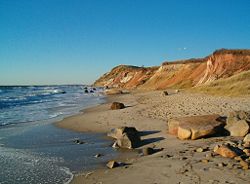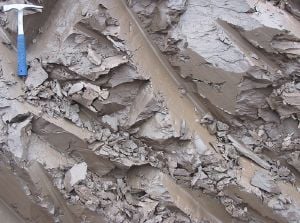Clay
- For other uses, see Clay (disambiguation).
Clay is a term used to describe a group of hydrous aluminium phyllosilicate (phyllosilicates being a subgroup of silicate minerals) minerals (see clay minerals), that are typically less than 2 μm (micrometres) in diameter. Clay consists of a variety of phyllosilicate minerals rich in silicon and aluminium oxides and hydroxides which include variable amounts of structural water. Clays are generally formed by the chemical weathering of silicate-bearing rocks by carbonic acid but some are formed by hydrothermal activity. Clays are distinguished from other small particles present in soils such as silt by their small size, flake or layered shape, affinity for water and high plasticity index.
Depending upon academic source, there are three or four main groups of clays: kaolinite, montmorillonite-smectite, illite, and chlorite (the latter group is not always considered a part of the clays and is sometimes classified as a separate group within the phyllosilicates). There are about thirty different types of 'pure' clays in these categories but most 'natural' clays are mixtures of these different types, along with other weathered minerals.
Montmorillonite, with a chemical formula of (Na,Ca)0.33(Al,Mg)2Si4O10(OH)2·nH2O, is typically formed as a weathering product of low silica rocks. Montmorillonite is a member of the smectite group and a major component of bentonite.
Varve (or varved clay) is clay with visible annual layers, formed by seasonal differences in erosion and organic content. This type of deposit is common in former glacial lakes from the ice age.
Quick clay is a unique type of marine clay, indigenous to the glaciated terrains of Norway, Canada, and Sweden. It is a highly sensitive clay, prone to liquefaction which has been involved in several deadly landslides.
Historical and modern uses of clay
Clay is plastic when wet, which means it can be easily shaped. When dry, it becomes firm and when subject to high temperature, known as firing, permanent physical and chemical reactions occur which, amongst other changes, causes the clay to be hardened. A fireplace or oven specifically designed for hardening clay is called a kiln. These properties make clay an ideal substance for making durable pottery items, both practical and decorative, with different types of clay and firing conditions giving earthenware, stoneware and porcelain. Early humans discovered the useful properties of clay in prehistoric times, and one of the earliest artifacts ever uncovered is a drinking vessel made of sun-dried clay. Depending on the content of the soil, clay can appear in various colors, from a dull gray to a deep orange-red.
Clays sintered in fire were the first ceramic, and remain one of the cheapest to produce and most widely used materials even in the present day. Bricks, cooking pots, art objects, dishware and even musical instruments such as the ocarina are all made with clay. Clay is also used in many industrial processes, such as paper making, cement production, pottery, and chemical filtering.
See also
- Ceramic
- Clay pit
- Clay minerals
- Grain size
- List of minerals
- Plasticine
- Clay (industrial plasticine)
- Pottery
- Clay court
- London clay
- Modelling clay
- Paperclay
ReferencesISBN links support NWE through referral fees
- Clay mineral nomenclature American Mineralogist.
External links
- WHO (2005), Bentonite, kaolin, and selected clay minerals, number 231 in ‘Environmental Health Criteria’, WHO. Available from: http://www.who.int/entity/ipcs/publications/ehc/ehc231.pdf
- Clay used as building material. Building with clay
ca:Argila cs:Jíl da:Ler de:Tonmineral et:Savi es:Arcilla eo:Argilo fr:Argile id:Tanah liat it:Argilla he:חרסית lv:Māli lt:Molis (uoliena) ms:Tanah liat nl:Klei ja:粘土 no:Leire ug:سېغىز توپا pl:Glina (skała) pt:Argila ro:Clay ru:Глина simple:Clay fi:Savi sv:Lera vi:Đất sét tr:Kil uk:Глина


